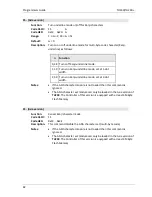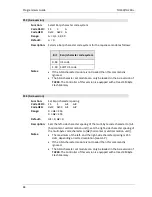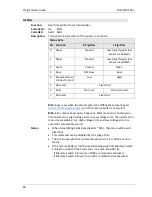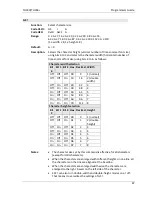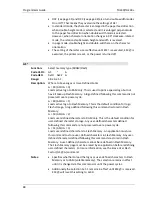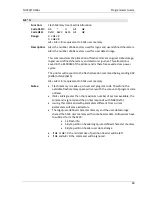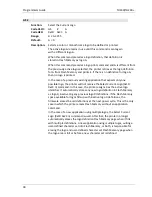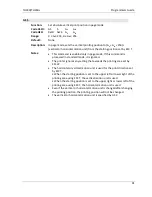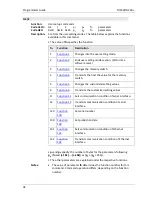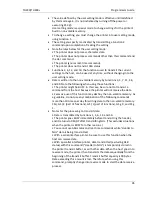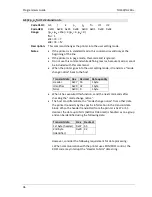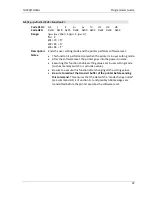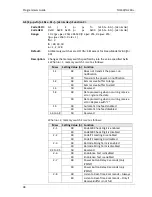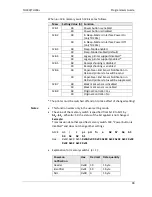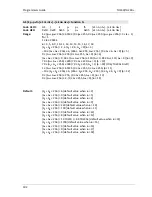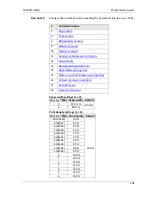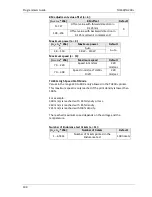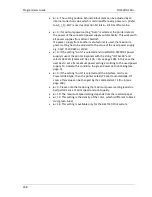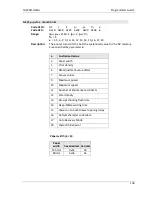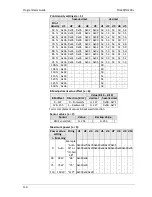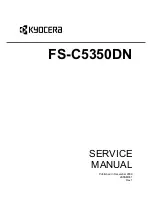
TH230/TH230+
Programmers Guide
95
•
The value defined by the user setting mode is effective until redefined
by this mode again. It is not initialized by turning off the power or
executing ESC @.
User setting mode is a special mode to change settings for the printer’s
built-in non-volatile memory.
•
To change a setting, you must change the printer into user setting mode,
using Function 1.
•
The setting you specify is activated by transmitting a Function 2
command upon completion of making the setting.
•
Note the rules below for the user setting mode:
• The printer does not process character data.
• The printer does not process commands other than this command and
the GS I command.
• The printer ignores real-time commands.
• The printer does not transmit ASB status.
•
Functions 4, 6, 12, and 50, the functions used to transmit the current
settings to the host, can be used at any time, without changing into the
user setting mode.
•
Data is written to the non-volatile memory by Functions 3, 5, 7, 11, 48,
and 49. Note the following when using those functions:
• The printer might be BUSY. In this case, be sure not to transmit a
command from the host because the printer will not receive the data.
• Excessive use of this function may destroy the non-volatile memory. As
a guideline, do not use any combination of the following commands
more than 10 times per day for writing data to the non-volatile memory:
FS q, GS ( E (part of functions), GS ( L (part of functions), GS g 0, and FS g
1.
•
Notes for the processing to transmit data:
• Data is transmitted by Functions 1, 4, 6, 12, and 50.
• The printer goes BUSY immediately before transmitting the header,
and it returns to READY after transmitting NUL. (This excludes situations
when the printer is BUSY for other reasons.)
• You cannot use ASB status and real-time commands while “Header to
NUL” data is being transmitted.
• With a serial interface printer, be sure to use this function when the
host can receive data.
• With a parallel interface printer, data transmitted (excluding ASB
status) with this command (“Header to NUL”) is temporarily stored in
the printer transmit buffer, as with other data. When the host goes into
reverse mode, the printer then transmits the data sequentially from the
beginning of the transmit buffer. Transmit buffer capacity is 99 bytes.
Data exceeding this amount is lost. Therefore, when using this
command, promptly change into reverse mode to start the data receive
process.
Summary of Contents for TH230
Page 1: ...TH230 TH230 POS Printer Programmers Guide July 2013 ...
Page 3: ...TH230 TH230 POS Printer Programmers Guide July 2013 ...
Page 214: ...TH230 TH230 Programmers Guide 207 Character code table Page 1 PC850 Multilingual Latin I ...
Page 215: ...Programmers Guide TH230 TH230 208 Character code table Page 2 PC852 Latin II ...
Page 216: ...TH230 TH230 Programmers Guide 209 Character code table Page 3 PC860 Portuguese ...
Page 217: ...Programmers Guide TH230 TH230 210 Character code table Page 4 PC863 Canadian French ...
Page 218: ...TH230 TH230 Programmers Guide 211 Character code table Page 5 PC865 Nordic ...
Page 219: ...Programmers Guide TH230 TH230 212 Character code table Page 6 PC858 Multilingual I Euro ...
Page 220: ...TH230 TH230 Programmers Guide 213 Character code table Page 7 PC866 Russian ...
Page 221: ...Programmers Guide TH230 TH230 214 Character code table Page 8 WPC1252 Latin I ...
Page 222: ...TH230 TH230 Programmers Guide 215 Character code table Page 9 PC862 Hebrew ...
Page 223: ...Programmers Guide TH230 TH230 216 Character code table Page 10 PC737 Greek ...
Page 224: ...TH230 TH230 Programmers Guide 217 Character code table Page 11 PC874 Thai ...
Page 225: ...Programmers Guide TH230 TH230 218 Character code table Page 12 PC857 Turkish ...
Page 226: ...TH230 TH230 Programmers Guide 219 Character code table Page 16 WPC1254 Turkish ...
Page 227: ...Programmers Guide TH230 TH230 220 Character code table Page 17 WPC1250 Central Europe ...
Page 228: ...TH230 TH230 Programmers Guide 221 Character code table Page 18 WPC28591 Latin 1 ...
Page 229: ...Programmers Guide TH230 TH230 222 Character code table Page 19 WPC28592 Latin 2 ...
Page 230: ...TH230 TH230 Programmers Guide 223 Character code table Page 20 WPC28599 Turkish ...
Page 231: ...Programmers Guide TH230 TH230 224 Character code table Page 21 WPC28605 Latin 9 ...
Page 232: ...TH230 TH230 Programmers Guide 225 Character code table Page 22 PC864 Arabic ...
Page 233: ...Programmers Guide TH230 TH230 226 Character code table Page 23 PC720 Arabic ...
Page 234: ...TH230 TH230 Programmers Guide 227 Character code table Page 24 WPC1256 Arabic ...
Page 235: ...Programmers Guide TH230 TH230 228 Character code table Page 25 WPC28596 Arabic ...
Page 236: ...TH230 TH230 Programmers Guide 229 Character code table Page 26 KATAKANA Asia ...
Page 237: ...Programmers Guide TH230 TH230 230 Character code table Page 27 PC775 Baltic ...
Page 238: ...TH230 TH230 Programmers Guide 231 Character code table Page 28 WPC1257 Baltic ...
Page 239: ...Programmers Guide TH230 TH230 232 Character code table Page 29 WPC28594 Baltic ...
Page 293: ...Wincor Nixdorf International GmbH 2013 D 33094 Paderborn ...


